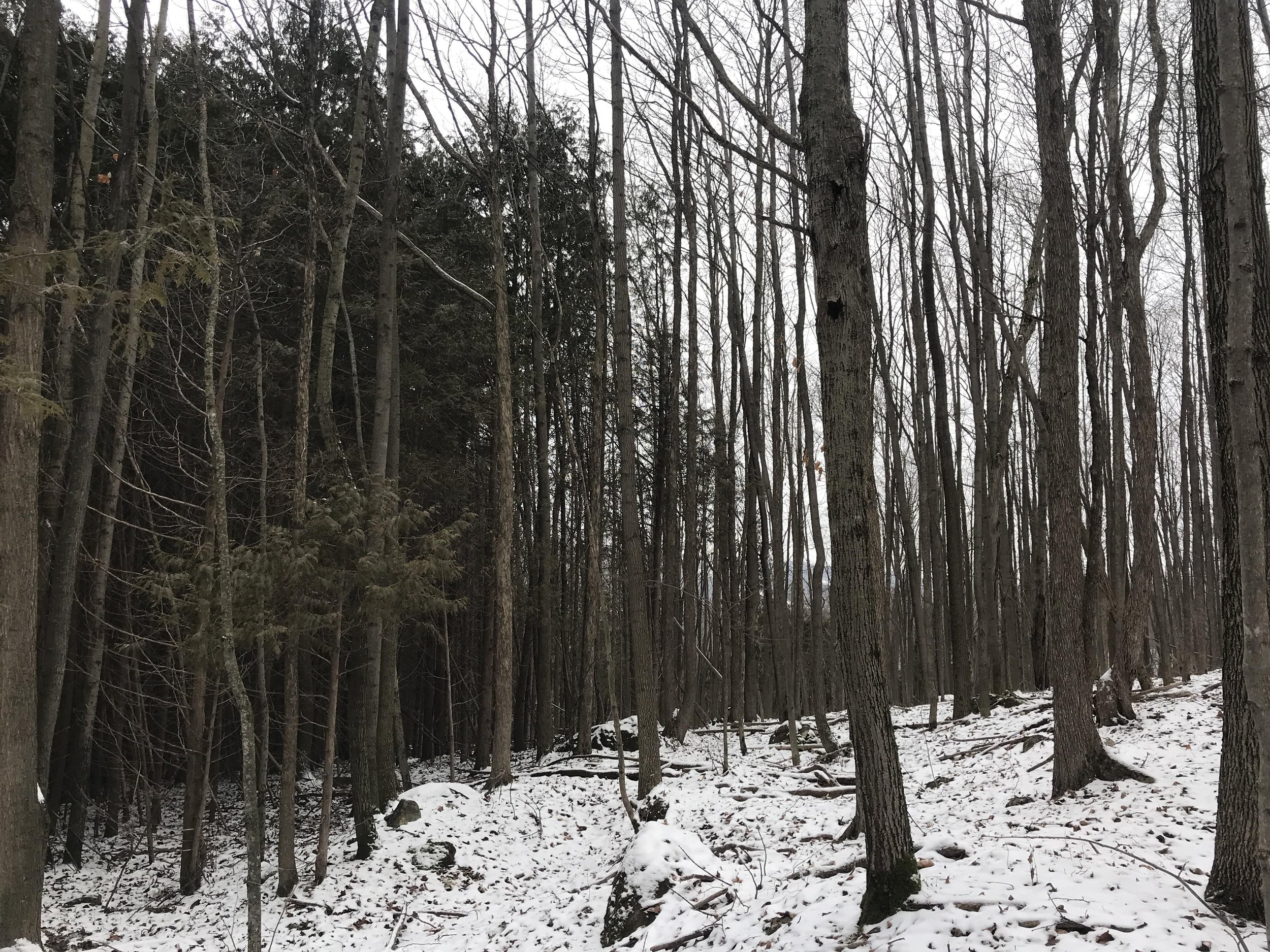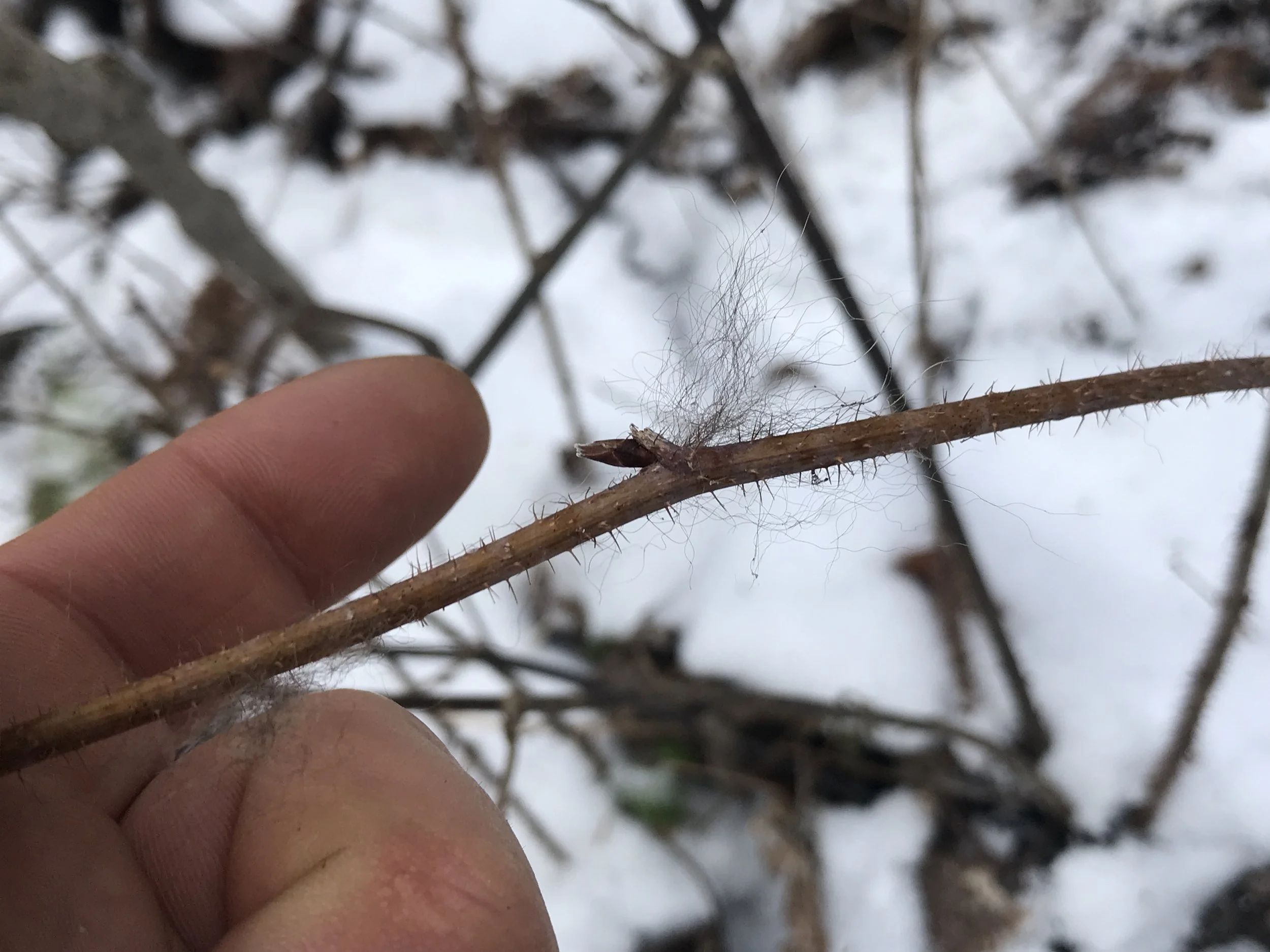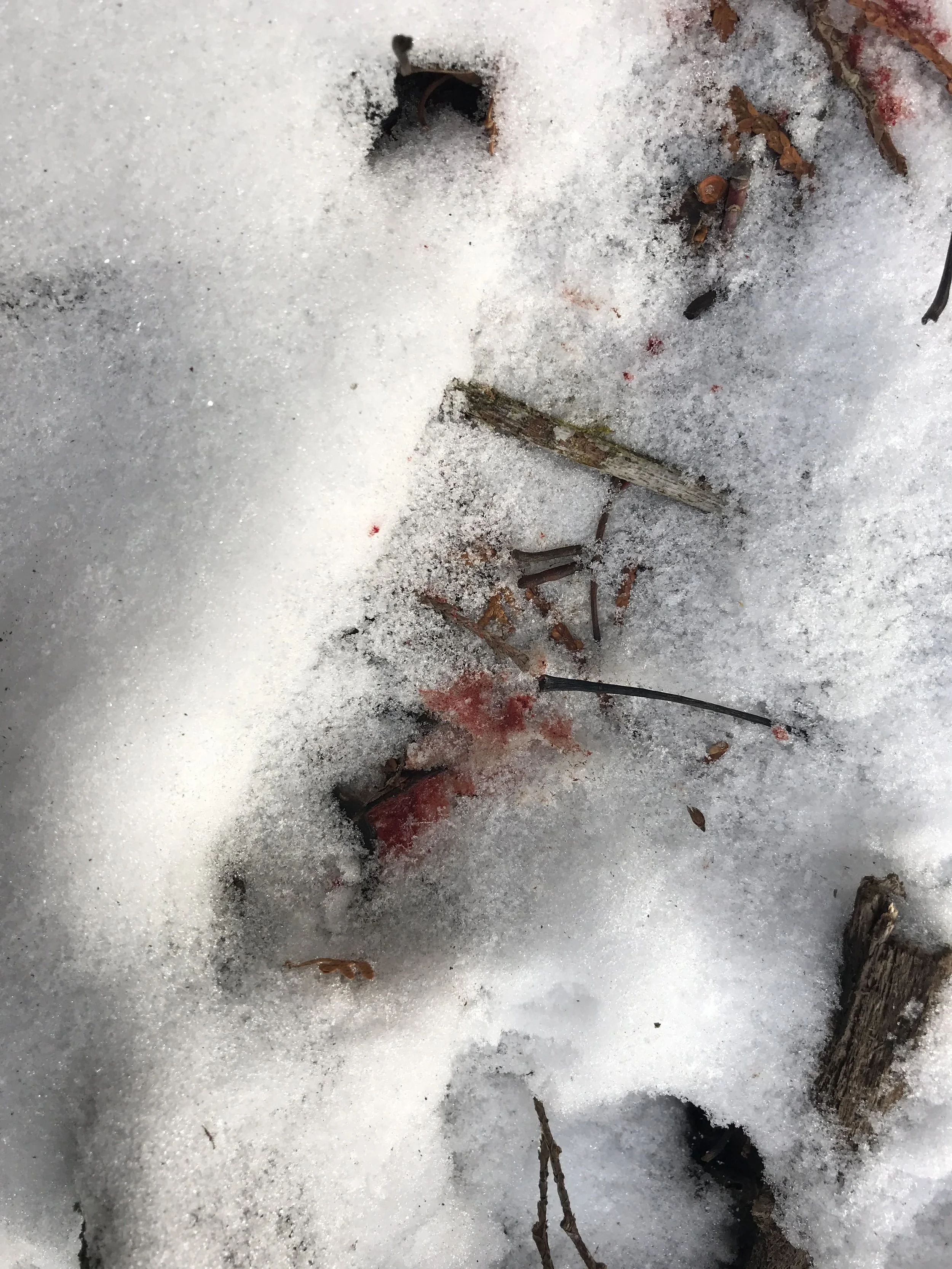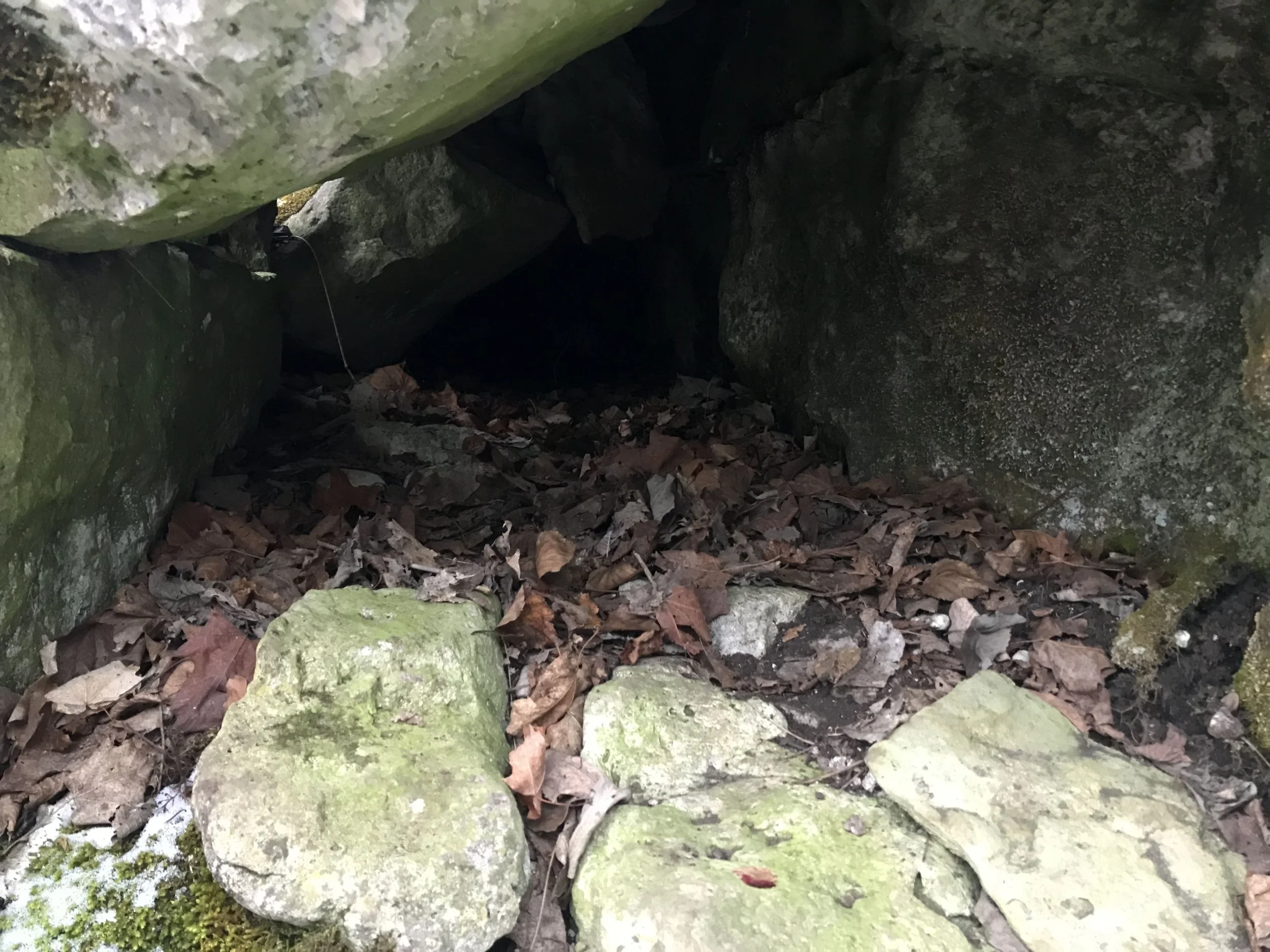Trailing a Fisher at Old Baldy
We had just crossed over from the thick White Cedar (Thuja occidentalis) forest into a little more spacious deciduous forest, when, in a very unassuming tone, Renato called us over to check out some tracks. I don’t know if he realized at first how cool the trail he had just found was, but as we stepped off of the path and looked down at the tracks everyone leaned in a little closer, and our voices started to ring with a little more excitement. Renato had found a Fisher (Pekania pennanti) trail.
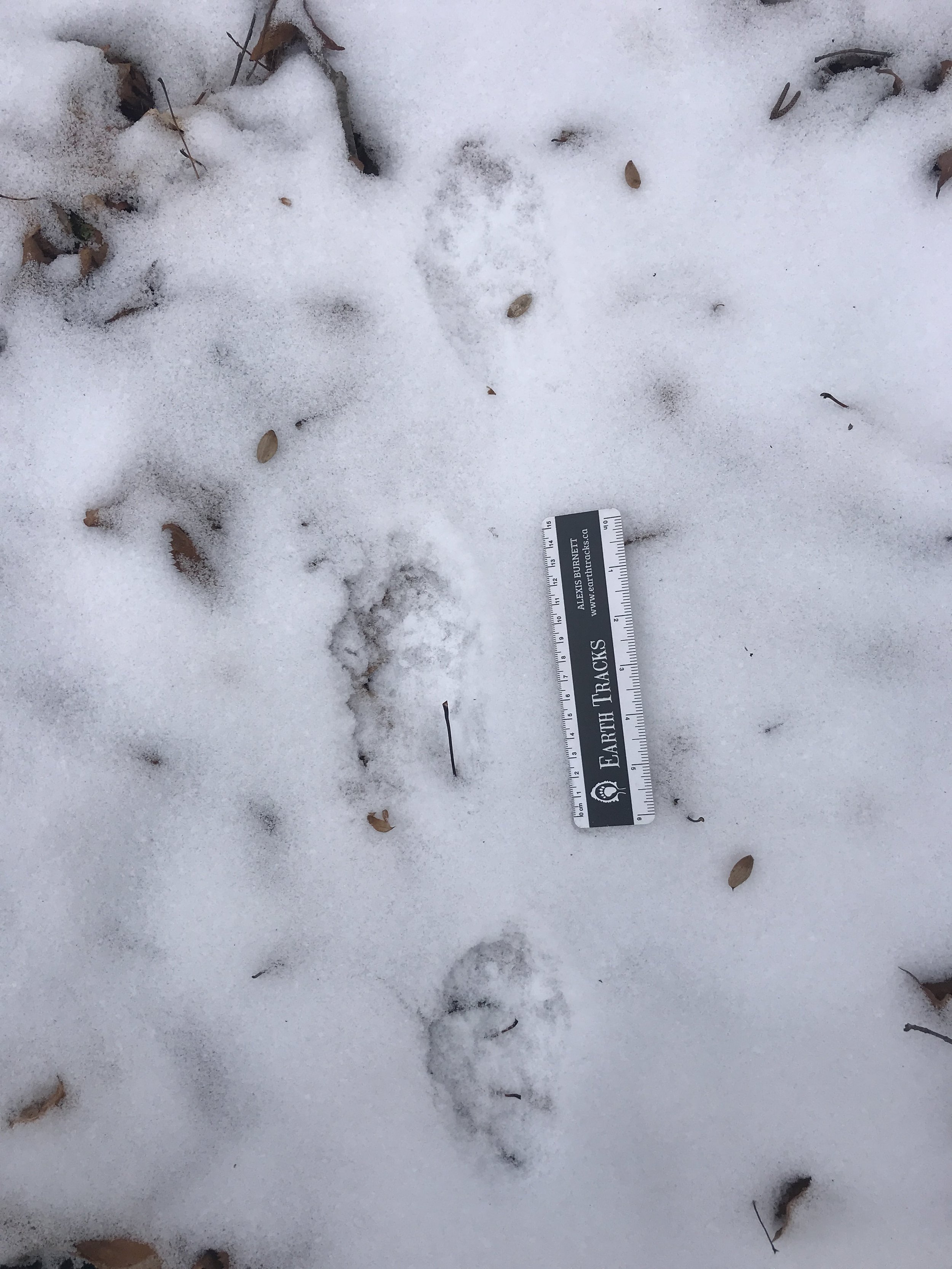
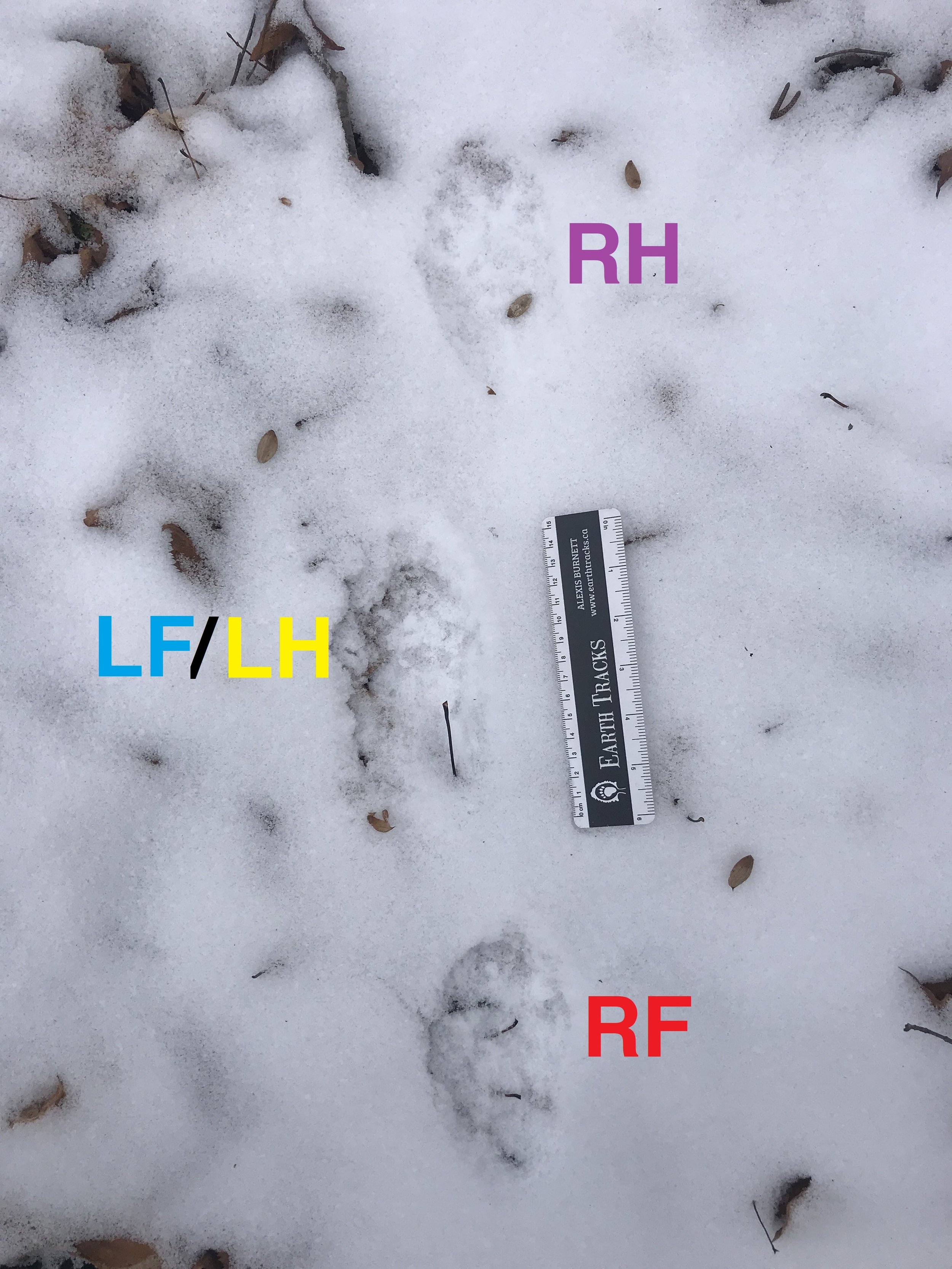
The first thing I noticed was the 3x4 loping gait pattern in the section of Fisher trail I was looking at. This pattern was repeated a couple of times in a row. What does a 3x4 loping gait mean? Glad you asked.
3X4 simply means that it looks like there are three impressions from the animal, but really there are four. It’s just that two of the tracks, left rear and right front in this case, are overlapping each other midway up the on the left side of the image.
In the book Mammal Tracks and Sign (Stackpole Books, 2019), Mark Elbroch describes a 3x4 lope as :
The 3x4 lope is a rotary lope, in which a front and hind on the same side of the body land in the same space, giving the impression of only three tracks in a set, rather than four.
Hildebrand and Goslow (2001) showed that weasels still have a front foot on the ground when the first hind foot touches down, and therefore this gait is a true lope.
The tracks we were encountering were on the larger side, 7.2 cm (2⅞ in) for the right front at the bottom of the image, ~7 cm (2¾ in) for the left front and left hind (these two were measured together as the left hind landed on top of where the left front previously was) and 6 cm (2⅜ in) for the right hind at the top of the image. The tracks were on the larger side of Fisher tracks I have found, implying a male, as the male and female Fishers can be quite different in size. In Tracking and the Art of Seeing (Firefly Books, 1999) Paul Rezendes says “If you see tracks over 2⅝ [in] wide, you can be fairly certain that you have a male fisher.” (Rezendes, 1999). And it’s not just the tracks. In Natural History of Canadian Mammals (University of Toronto Press, 2012) Donna Naughton writes that “[m]ales are considerably larger than females, about 15% - 25% longer in body length, and about twice as heavy on average.” (Naughton, 2012). This was very exciting. A previous time I was here with the tracking apprenticeship we had also come across Fisher tracks and we had assumed a male because of the size of the tracks. This got me wondering if this was from the same individual? Again according to Donna Naughton (Naughton, 2012, and from here on known simply as “Donna”) few Fishers live longer than five years in the wild, though some have been found who are 10 - 12 years old. Could be the same individual…
We were excited to get on this trail and start backtracking the animal and see where this individual had come from.
I can’t say that we followed the trail without issue. Old Baldy is a very steep hill and the Fisher kept switch backing up the hill, crisscrossing and occasionally just taking the human (Homo sapiens) made path over and over again as they made their way up. This path was littered with human and domestic Dog (Canis familiaris) tracks and we found it difficult to determine where the Fisher had gotten off of the path, but we all fanned out and eventually we found again. There were also a couple of confusing moments where we encountered Raccoon (Procyon lotor) tracks and in the snow and forest debris and we confused the two animals trails. But overall we did a pretty good job of following them.
There were some occasional surprises along the trail, like when the Fisher stopped and we could see the fronts directly beside each other, and the hinds directly beside each other. Alexis air-sculpted the body of the Fisher to give a better idea on the size of the animal. He also found a hair in the left front track which could have fallen from the Fisher.
Donna writes that male Fishers can get up to 90 - 120 cm (35⅜ - 47¼ in) in length from the tip of their nose to the end of their tails. She also notes that the tail is about 36.8 - 42.2 cm (14½ - 16¾ in) long, so going with the middle range of these measurements which is 105 cm (41¾ in), minus the length of the tail, 39.5 cm (15½ in), this comes out to a length of 65.5 cm (25¾ in).
Finding the mean of the female Fisher’s measurement range of 75 - 95 cm (29½ - 37⅜) total length minus 34 - 38 cm (13⅜ - 15 in) tail length is about 85 cm for total length and minus the 36 cm for tail length comes out to 49 cm (19¼ in). This doesn’t discount the number mentioned in the video above, but instead builds on the estimate with Donna’s numbers. I would say that we need to revisit the idea of a shoulder to hip ratio and add the additional length of the skull and cervical spine. I would like to try and do this math on other species we encounter and see if there is an equation or process to help us better estimate the length of an animal in the field?
Just to complicate things a little more, Dr. Scott LaPoint published an article on Fisher range expansion which also discussed how the Fishers in the NorthEast, including Southern Ontario and New York, we’re actually getting larger (check out my interview with Dr. LaPoint here). Could this mean that our assumptions of sex for Fishers in Ontario is growing more complex and we need to look into other factors? Could it be that larger females here are getting to be the size of smaller males in other parts of Turtle Island/North America? Just wondering.
After we trailed the Fisher for a while I noticed some scat, and as I zoomed out of my tunnel vision, some urine beside the scat. Alexis mentioned that this might be a roll, and my vision zoomed out again and I saw the mess of leaves below me.
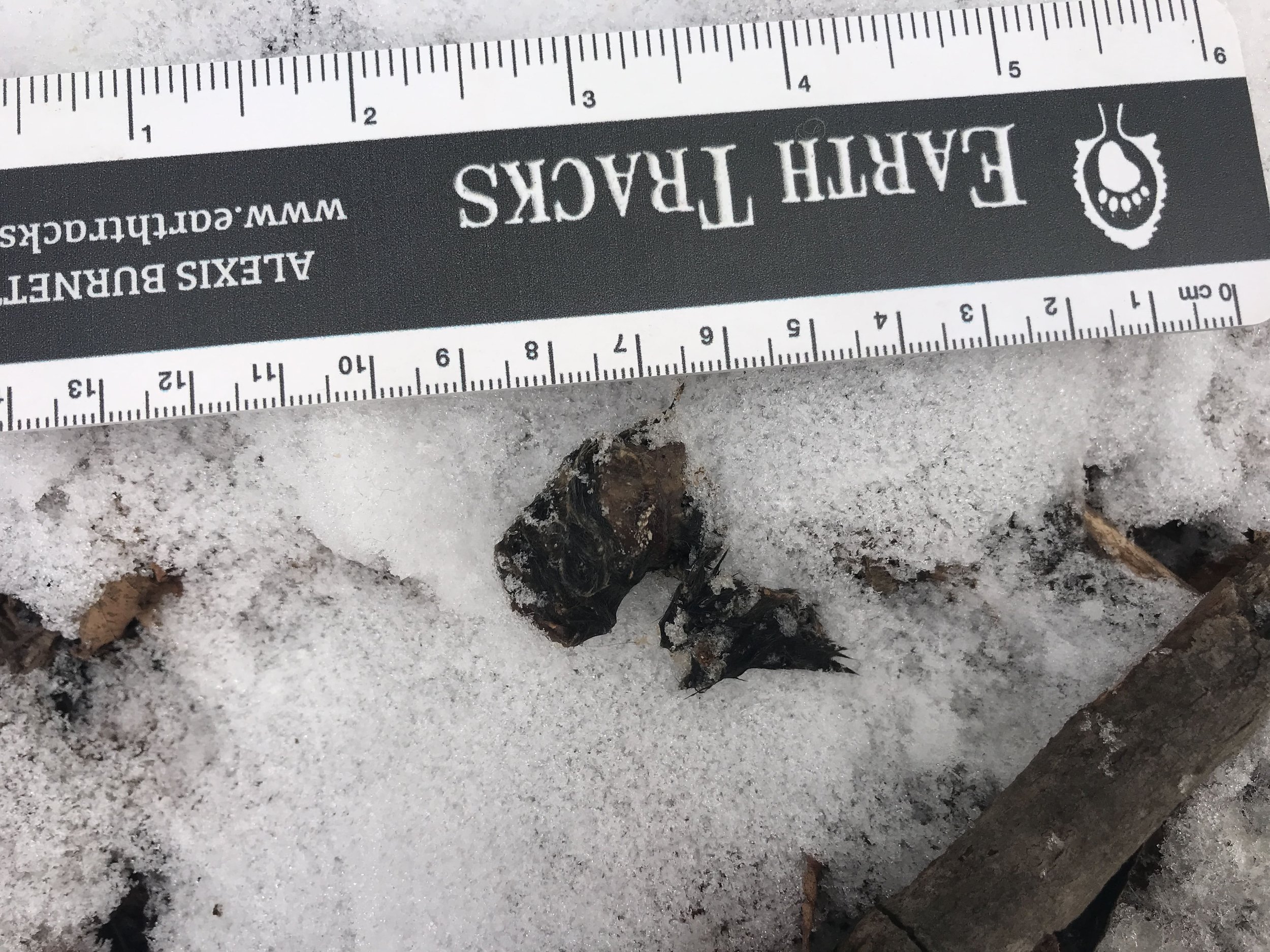
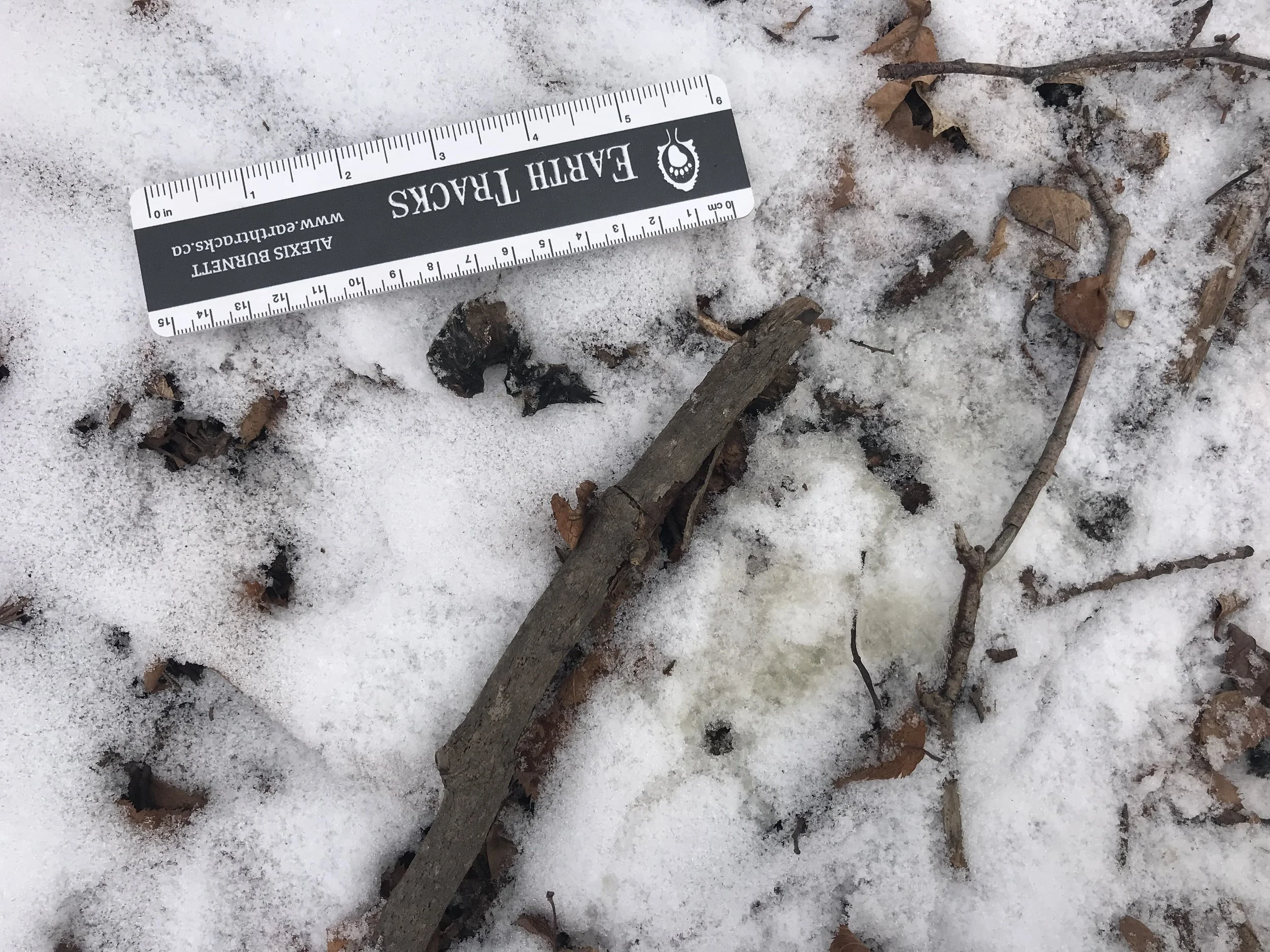
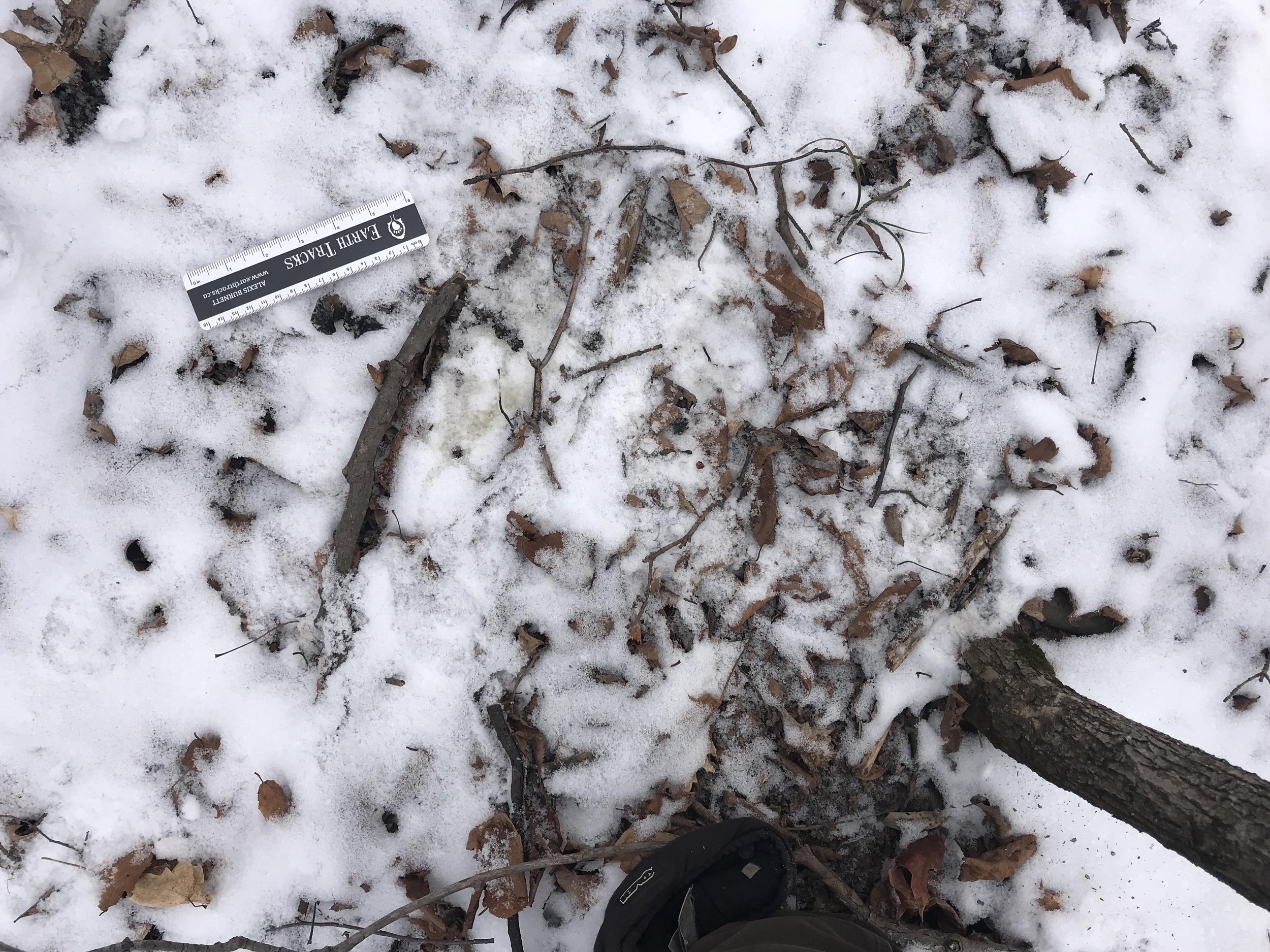
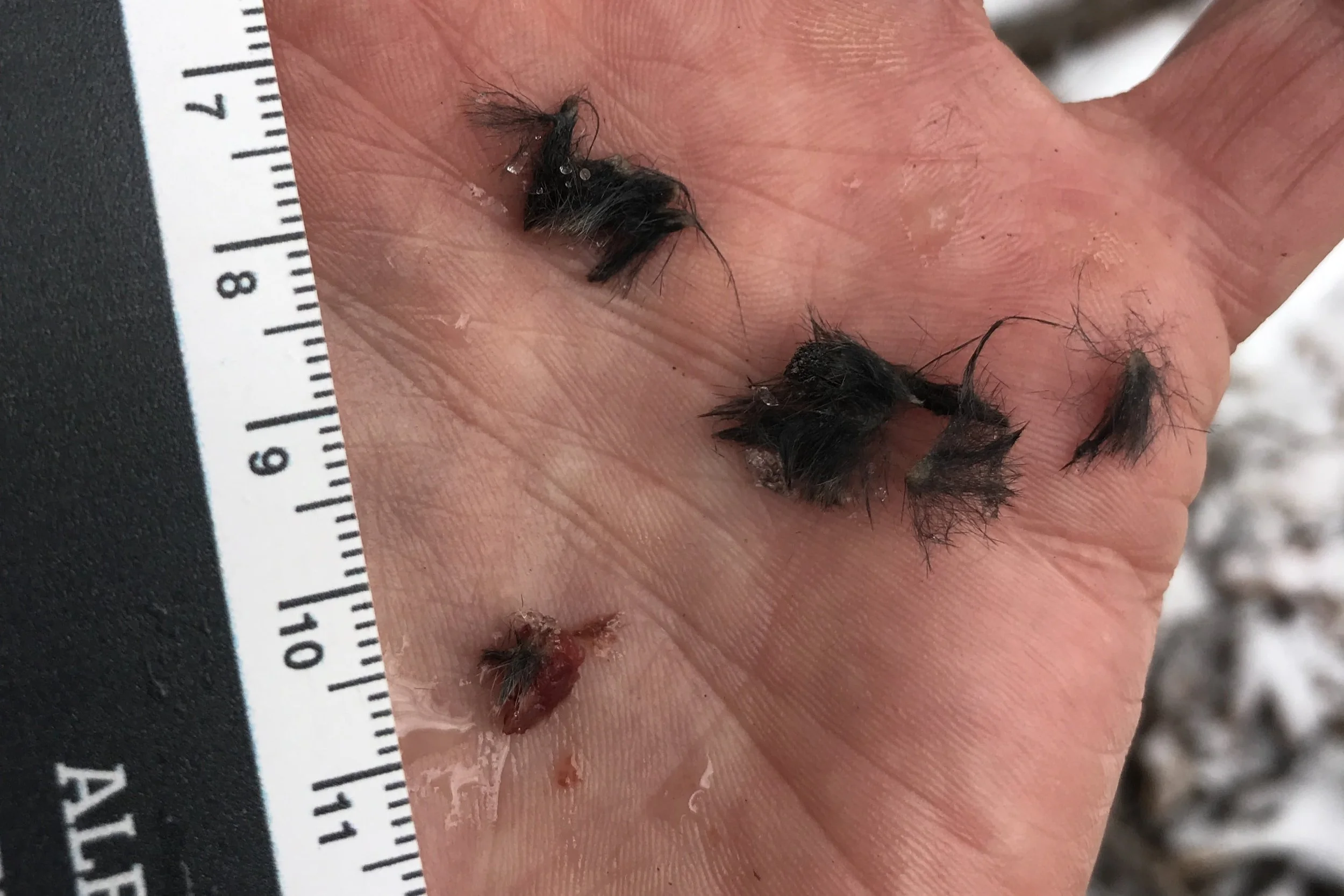
Like canids, felids, and other mustelids, Fishers will sometimes roll as a process of scent marking. Sometimes they find another animals scent mark and roll about in it, or make their own by depositing scat and urinating. This is my first time seeing sign which might be a roll, but the previous time I trailed a Fisher at Old Baldy, we did come across some scat and scent making on a log. Depositing scent on elevated surfaces is common for many species of carnivores. Speaking of carnivores, Fishers are often named as carnivores, but they also eat fruit and nuts when a preferred diet of meat isn’t available. The scat in the image was full of what looked like dark black hair. Alastair also found a clump of hair and a small piece of flesh. The hair in the scat in the image reminds me of an Eastern Cottontail Rabbit (Sylvilagus floridanus), or maybe a black morph Grey Squirrel (Sciurus carolinensis) or maybe even a vole or mouse of some kind? In the fourth photo in the gallery above, the one with the hand holding the hair and piece of flesh, I see some colour shifting from a blackish dark shade turning to grey in the clump in the upper left. This reminds me of the brindled look of a Cottontail coat, though I really can’t tell. Fishers will eat anything they can catch or any dead things they may come across. Not only consumers of animals, Fishers will also eat fruit and nuts and even the fruiting bodies of truffles, though I have read that in a study with captive Fishers, fruit and nuts were likely only consumed as a last resort. This generalist diet makes me fall in love with them even more. Fisher fruit and nut scat tends to be more tubular than the twisty tapering scat they deposit when eating meat. The scat form pictured above isn’t often described in books for mustelids, but I have found very similar, though smaller, scat along the river on a Mink (Neogale vison) trail in Guelph. It looks tubular, but not necessarily “extremely” twisted as Mark Elbroch describes (Elbroch and McFarland, 2019).
It took a while still to get only a little further on the Fisher trail. The Fisher wefted their way past more Raccoon, Fox (Vulpes vulpes), and Ruffed Grouse (Bonasa umbellus) trails as well as a couple of White-tailed Deer beds overlooking a steep drop into a ravine where we stopped for lunch. I have taken up Tamara Anderson’s challenge of trying to find a hair in every deer bed I come across and it seems throughout the Winter it is a pretty easy game. I found three hairs in the bed pictured below.
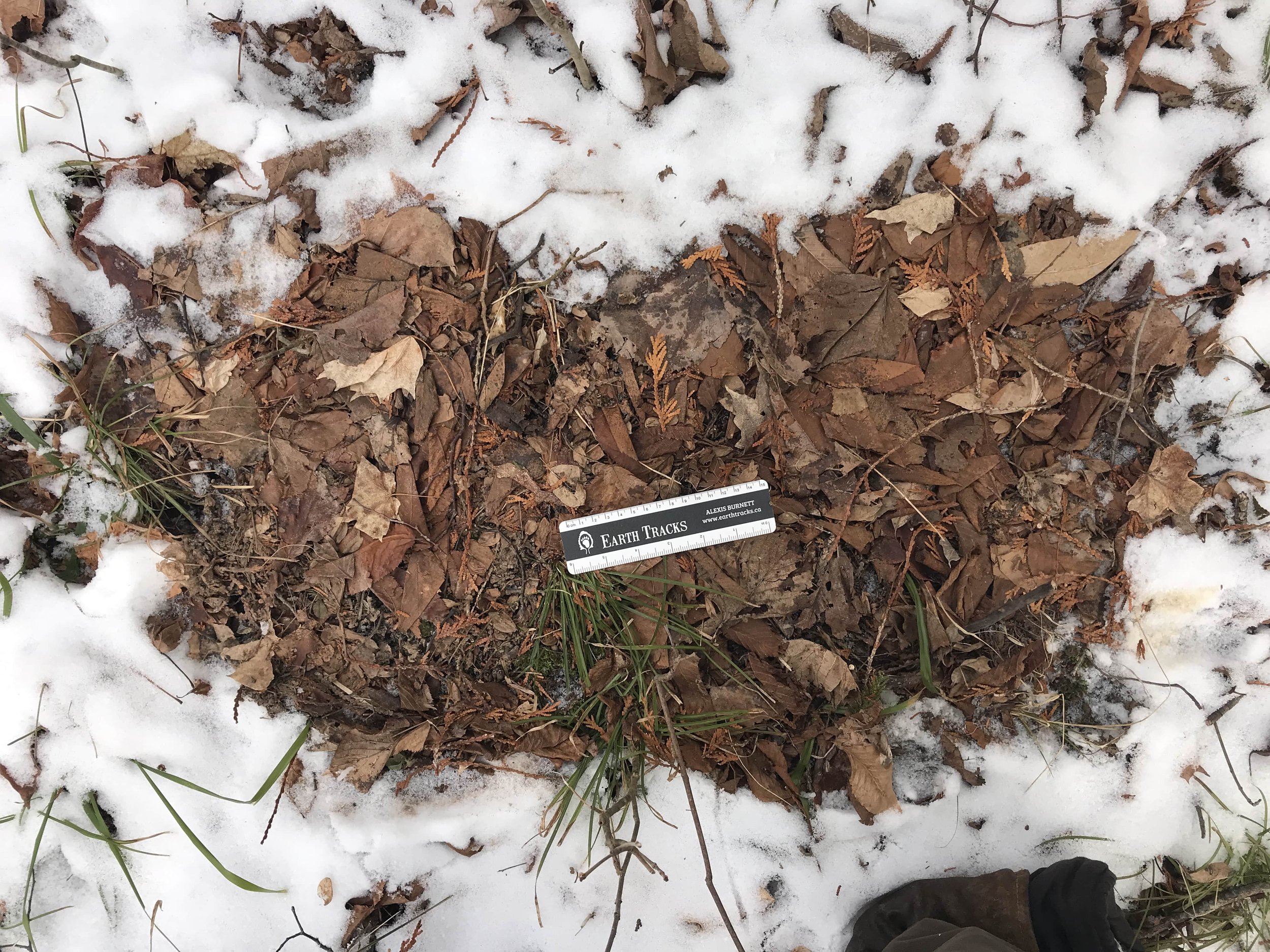
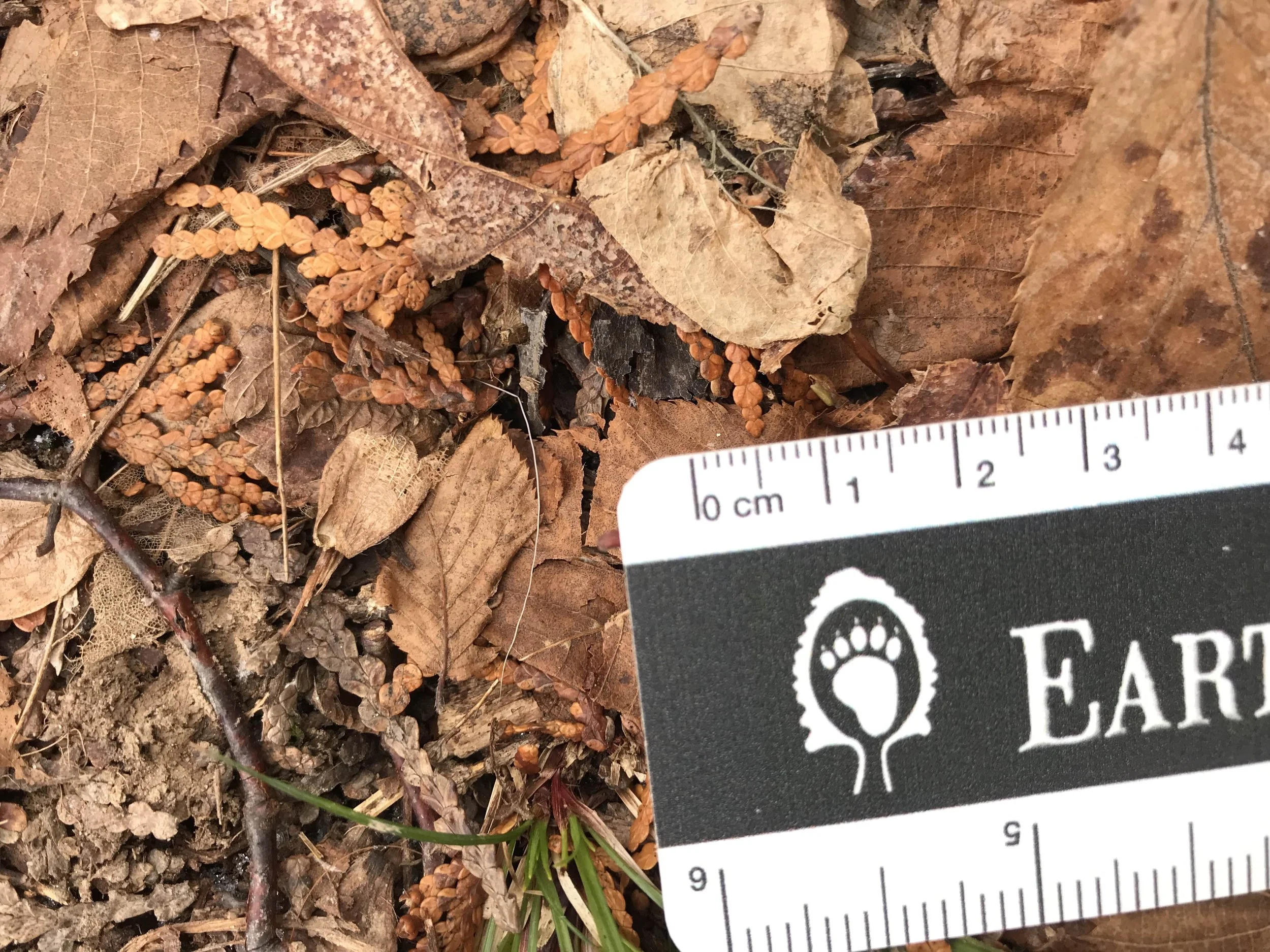
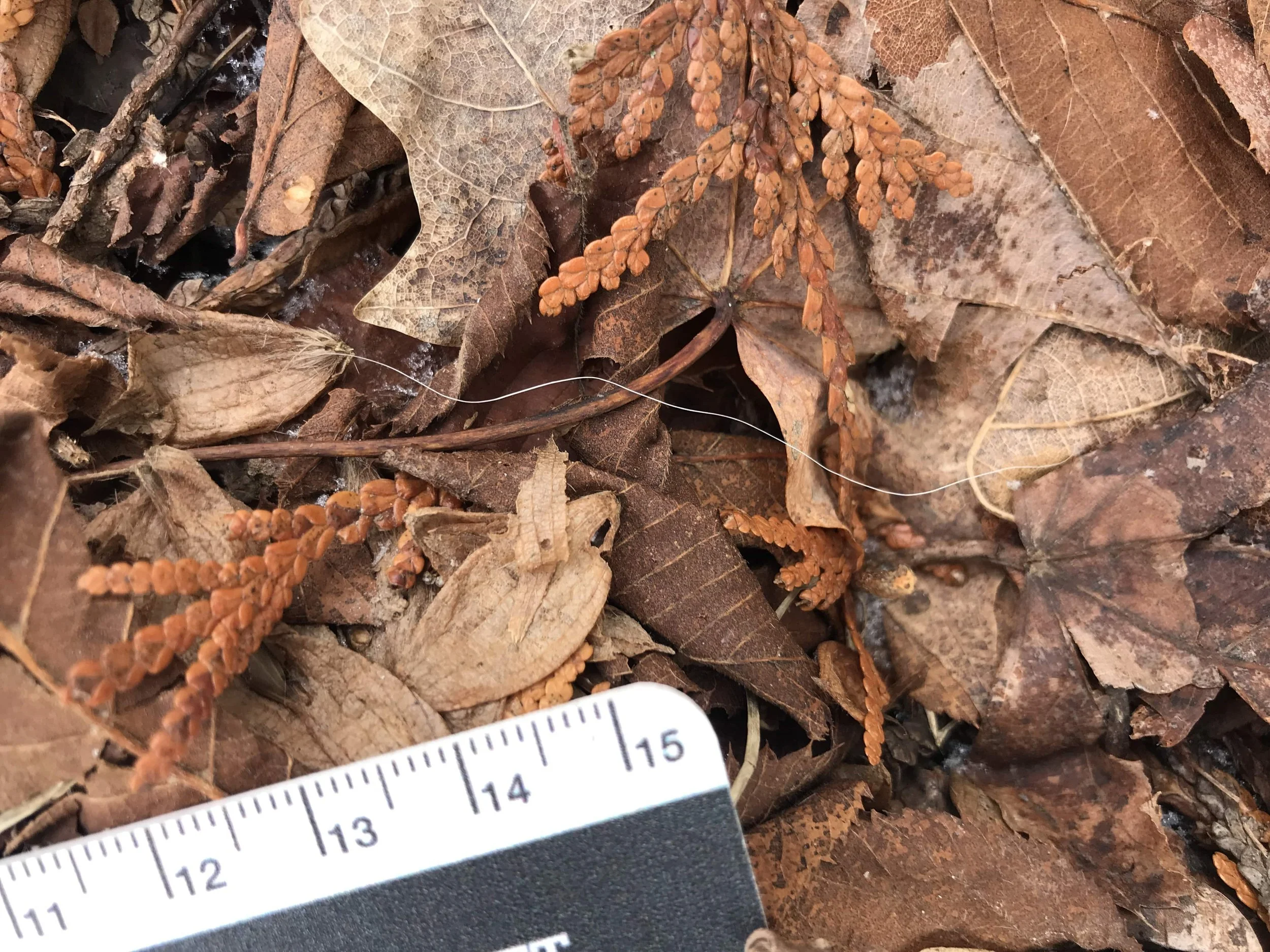
After lunch we moved on to a small boulder field nestled under some more Eastern White Cedars. The first three of us to arrive started to check out what looked like a fresher Fisher trail with tracks about the same size as the trail we were on but going in a different direction. I believe the three of us assumed that it was the same Fisher who we had been following, but that they had turned around and began heading in a new direction. While discussing the tracks, the three other trackers in our group came up and continued on the first trail. Since we believed they would shortly be meeting us we decided to check out a group of four tracks and discuss the placement of foot falls.
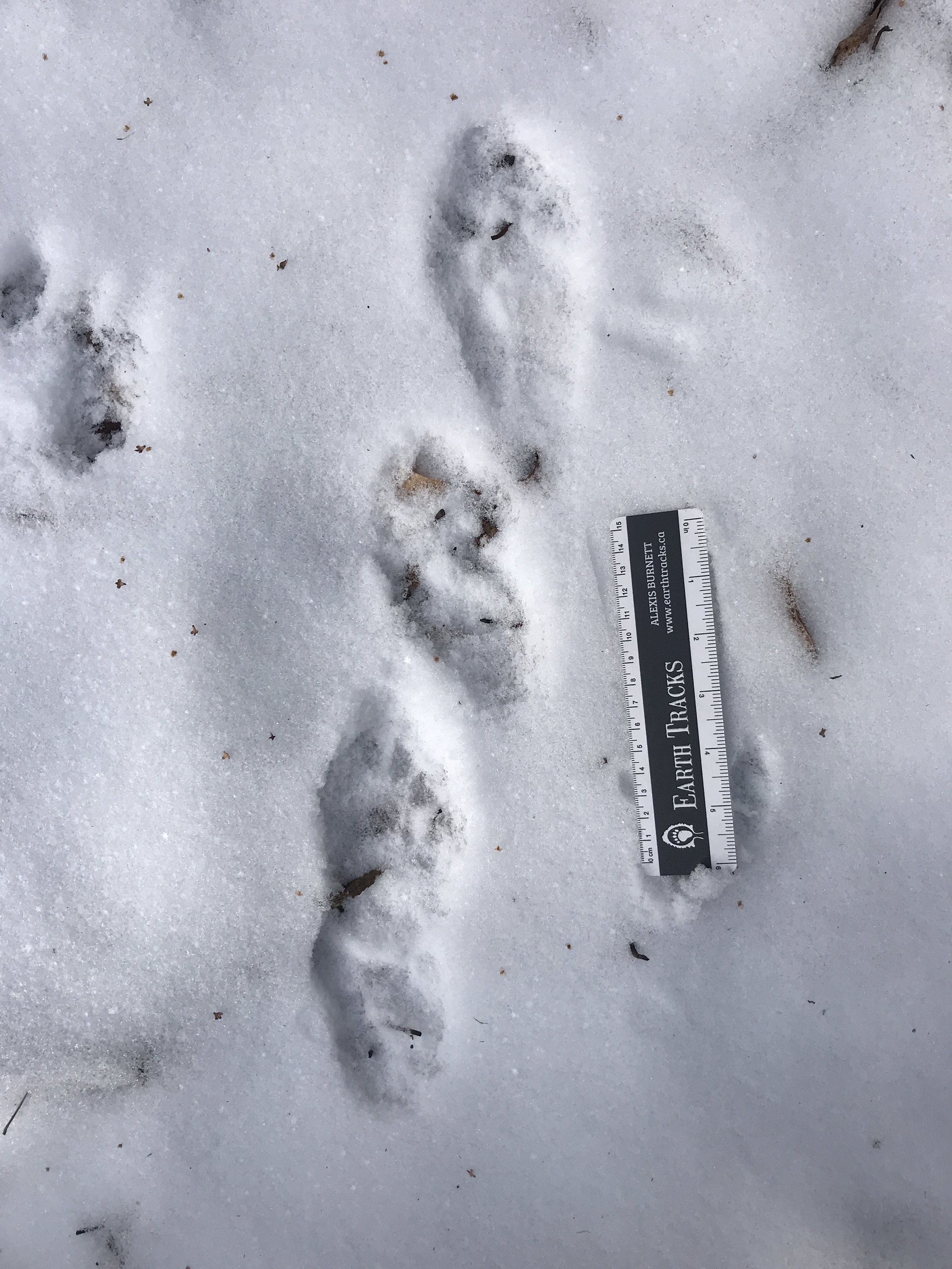
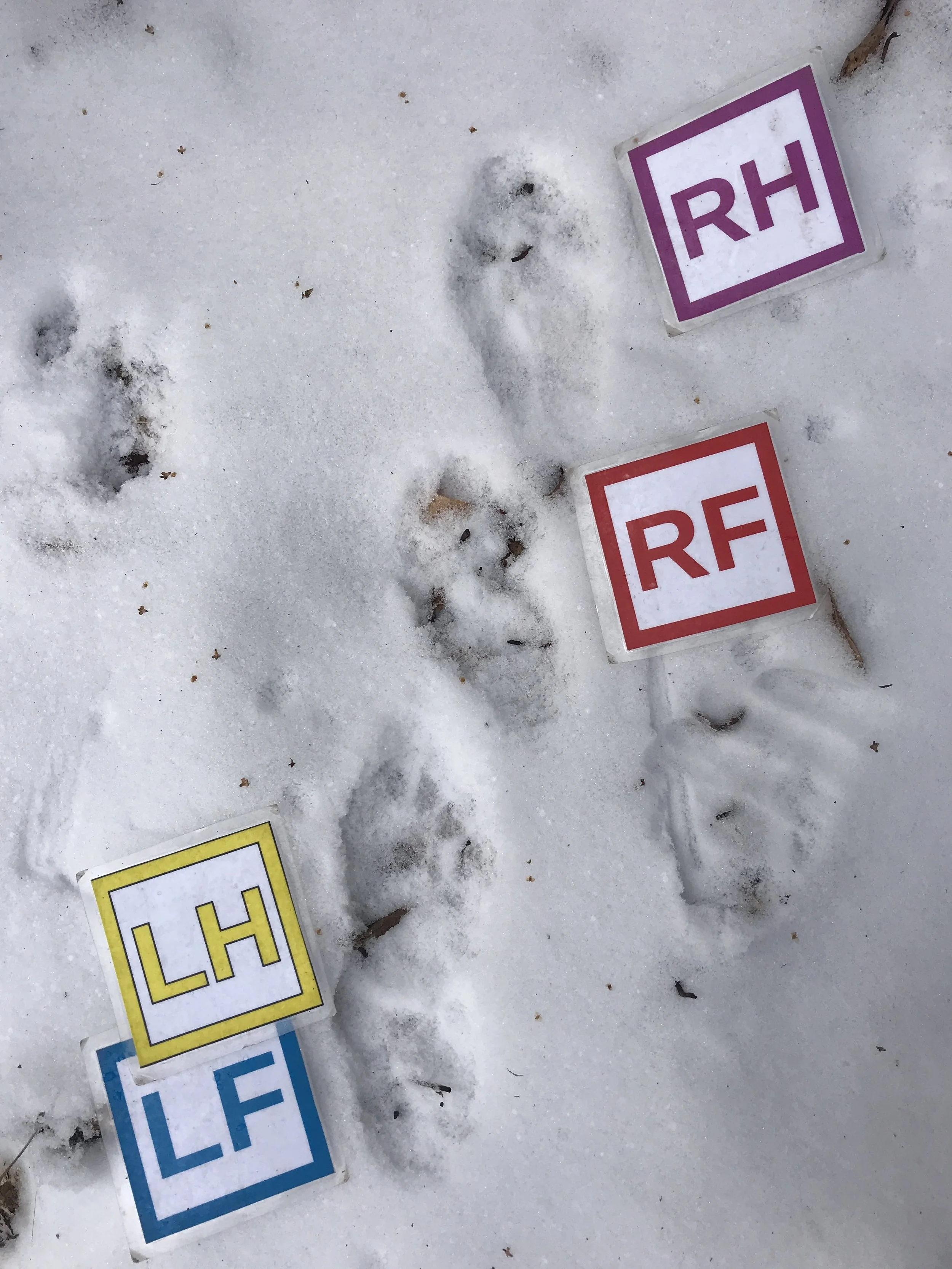
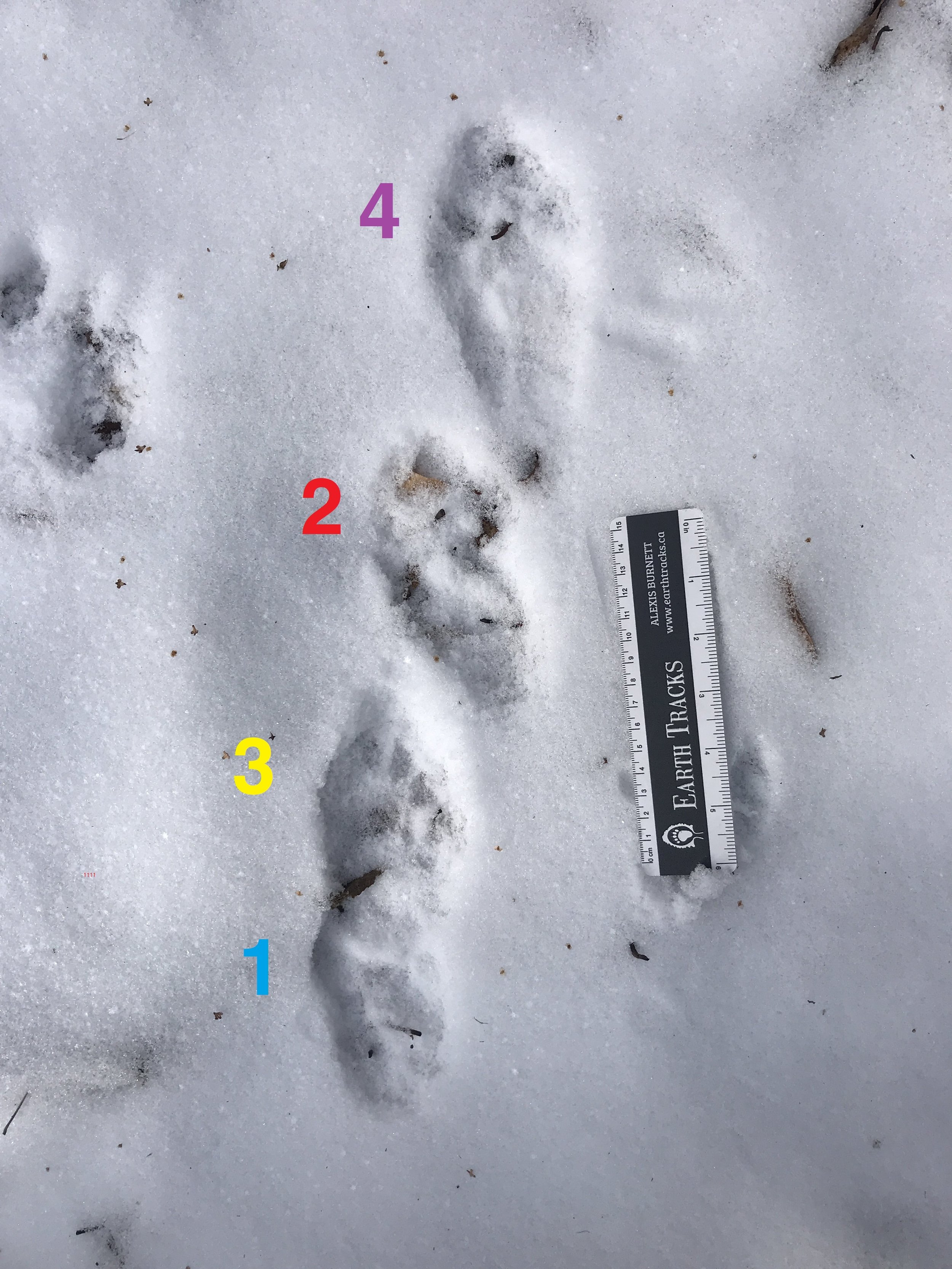
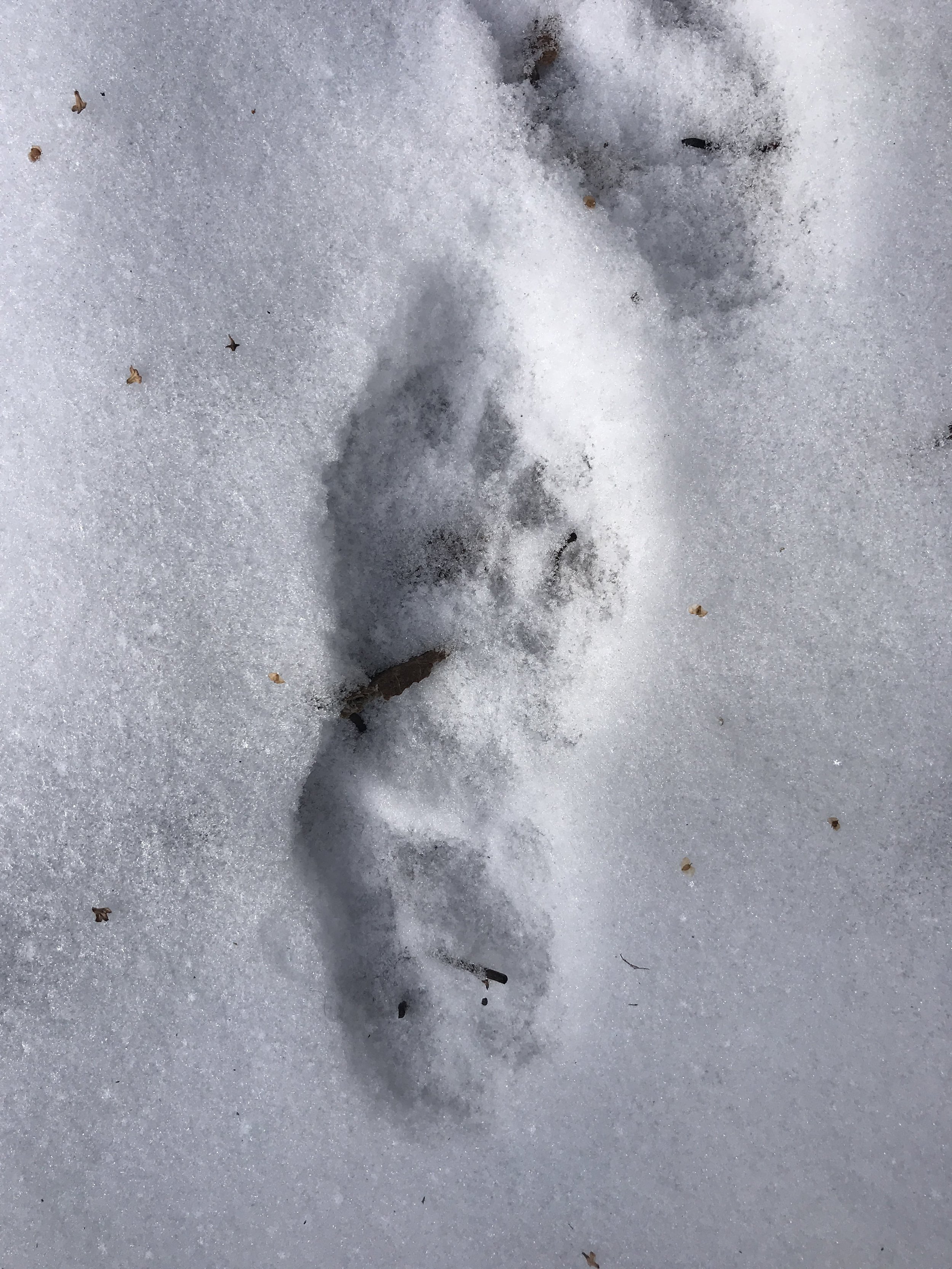
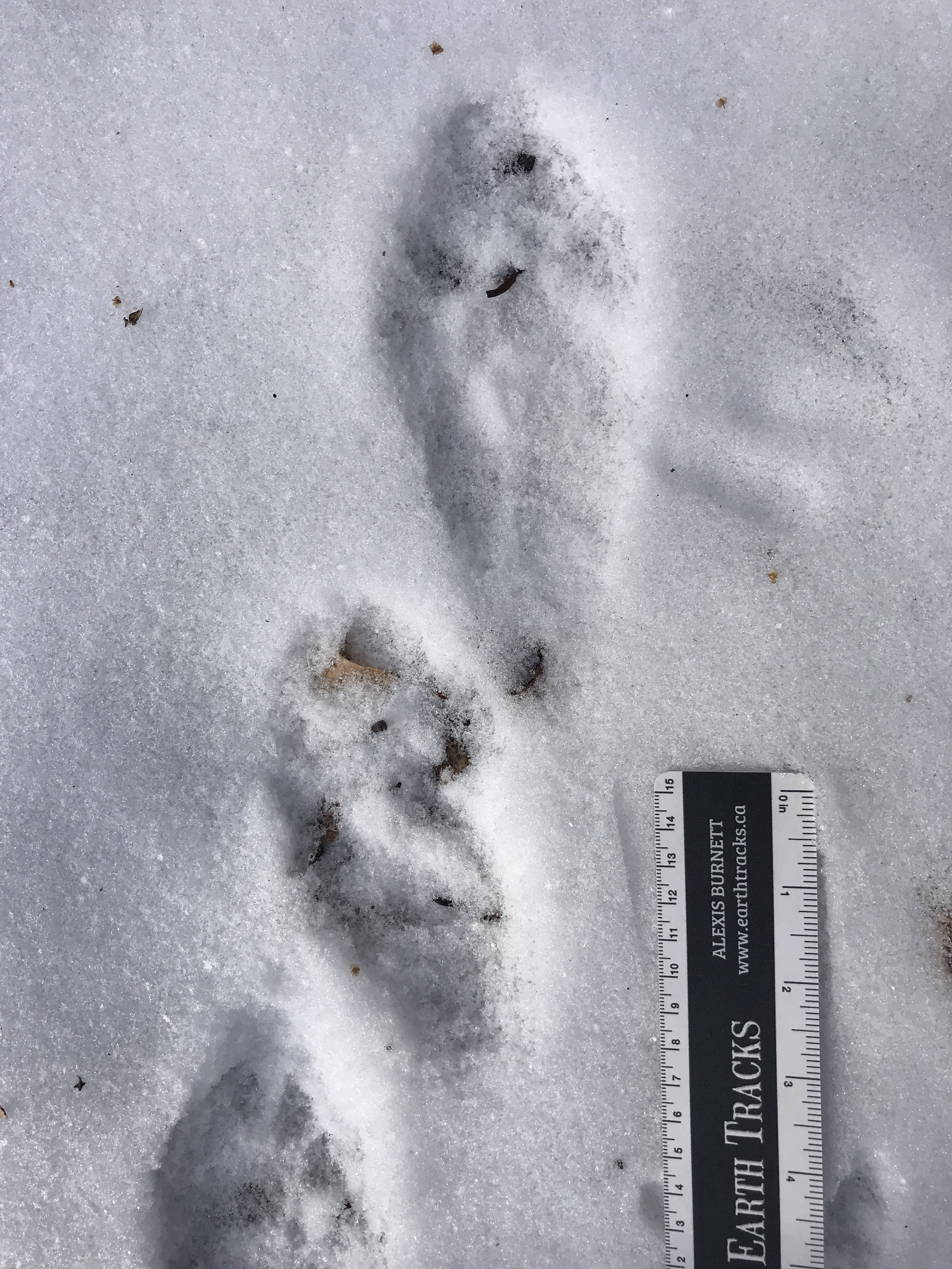
We spent bit of time checking out the lope, waiting for our colleagues to return, but when we realized they were off a ways, we decided to send them a text and start foretracking the Fisher. We were going up and over the boulders around us, up and around, following a slow going and difficult path. But it was a ton of fun. At one point I looked over and saw James standing precariously on the snowy edge of a high boulder, gripping some thin branches of a small shrub. He looked wild with glee and I was reminded of the wandering and exploring of my brothers and I when I was a child. What a joy it was to be on the trail with these friends.
At times the trail was frustrating, like when we’d lose the Fisher in a mess of Red Fox, Raccoon and Domestic Dog tracks, but eventually things got even more interesting. At one point when James was higher up he noticed some Rabbit hair on the ground, and around the same time I noticed some blood close by. We decided it was likely that the blood was from the Cottontail Rabbit which had been hunted by either the Fisher or a Red Fox.
Tracking is sometimes a bit of projection, putting the signs together with a bit of storytelling in our minds, a bit of imagination of how the Fisher was moving, what they might have been feeling or thinking. We practice putting on the ecological awareness’ and senses and ways of knowing that we suspect a Fisher might have and while trying to embody and “em-mind” this new way of observing we imagine the story of the Fisher and if it was them who got the Cottontail. I think we all came to our own conclusions that yes, it was the Fisher and when we found their trail once more, we also found more blood, and more Cottontail hair, this time tangled within a Raspberry (Rubus spp.) cane.
When we realized that the Fisher must have nabbed the Rabbit before they got to the place where we were, we decided to backtrack the Fisher the Fisher trail, going in the direction that he(?) had come from. Along the backtrail we came across another bit of blood, sometimes a drop, sometimes a big glob every couple of meters right in the midst of the trail. I tried to see if the blood was coming from a specific foot, to see if the Fisher had injured themselves on something, but it didn’t seem like that was the case. It seemed like it was in fact blood coming from something which we could imagine might have been dangling from the Fisher’s mouth.
It was really cool to notice how clear the blood was in the snow. Sometimes the tracks were hard to see clearly, but the blood we could see from quite a way off. It almost seemed to glow in our eyes. Perhaps this is some ancient evolutionary trick of the eyes to help us see wounds on ourselves or those we love quickly, or additionally, to be able to follow a blood trail from any animals we may have wounded while hunting?
Our eyes detect colours in different wavelengths because of the three different types of cone cells. L cones perceive long wavelengths, M cones perceive medium wavelengths, and S cones perceive short wavelengths. Now, think of a rainbow, with red, orange, yellow, green, blue, violet. Red is the longest wavelength we can perceive and violet is the shortest wavelength we can perceive. Interestingly, the majority of cones in our eyes are the L type, meaning our eyes are pretty sensitive to the lower wavelengths, think red light, meaning our vision is best for warmer colors like reds, oranges and yellows. Perhaps because we have more of these cones and due to the contrast with the white snow, the blood really stood out for us? This is something I want to learn more about as I really don’t know much yet but it seems really interesting to me. Basic biology I bet, but still a ton of fun.
As we followed the blood trail we really started to make good time, which was important, because we were running out of time. We needed to meet the other folks we’d come with back at the vehicles by 4:30. By this time we were scrambling further and further up the steep hill which is Old Baldy, heading further and further North away from the cars. We were getting a bit of a workout from the climb and slipping, then clambering back up again. Eventually the blood trail led somewhere interesting. We came to a cave.
It was a smaller cave, about the size of my winter bundled body in width though quite a bit longer than me (178 cm or ~5’8”). There was blood on a couple of leaves out front and on one of the rocks at the threshold. One side of the cave wall was solid rock, the other wall were rocks which had fallen from further up the hill. Inside there were dry and crunchy deciduous leaves and a small pile of ancient Raccoon scat. I removed the scat, and crawled in the cave in search of any sign that the Fisher had killed or taken their prey there. There was nothing. I proposed to the idea to the folks I was with but they then let me know that the backtrail continued on beyond the cave outside, with more signs of blood. I heard this and I was saddened a little as we had to start heading back down the hill and get on the trail back to the cars.
Still full of excitement and contentment we made our way back down. I noted some deer trails and Grey Squirrel runs, but was thinking about all of the previous times we had tracked here. I remembered trailing out the Coyotes (Canis latrans), the Fishers, the Grouse. When we got to the trail we paused for a bit and heard the others coming along. We all stopped and shared stories when we met up with the other group and found out that they had gone down a long ravine crisscrossing boulders and tricky terrain and then finally the trail they were on turned and went back up to meet the trail we had been on, all of us following the same Fisher.
It really was a lovely day trailing an inspiring animal, leading us through a story of day in the life of a Fisher. Well worth my Sunday. Big thanks to the folks who were there, sharing the adventure.
To Learn More :
Mammal Tracks and Sign by Mark Elbroch and Casey McFarland. Stackpole Books, 2019.
Tracking and the Art of Seeing by Paul Rezendes. Firefly Books, 1999.
Natural History of Canadian Mammals by Donna Naughton. University of Toronto Press, 2012.
Previous tracking journal from Old Baldy, also featuring trailing a Fisher
Mesopredator release facilitates range expansion in fisher by Dr. Scott LaPoint.
Interview with Fisher researcher Dr. Scott LaPoint
Fisher Species Profile by Roger A. Powell, Published May 8, 1981 by The American Society of Mammalogists (pdf)
Fisher and Marten Chapter from Wild Mammals of North America edited by George A. Feldhamer, Bruce C. Thompson, and Joseph A. Chapman. John Hopkins University Press, 2003. (pdf)

